#omecihuatl
Text


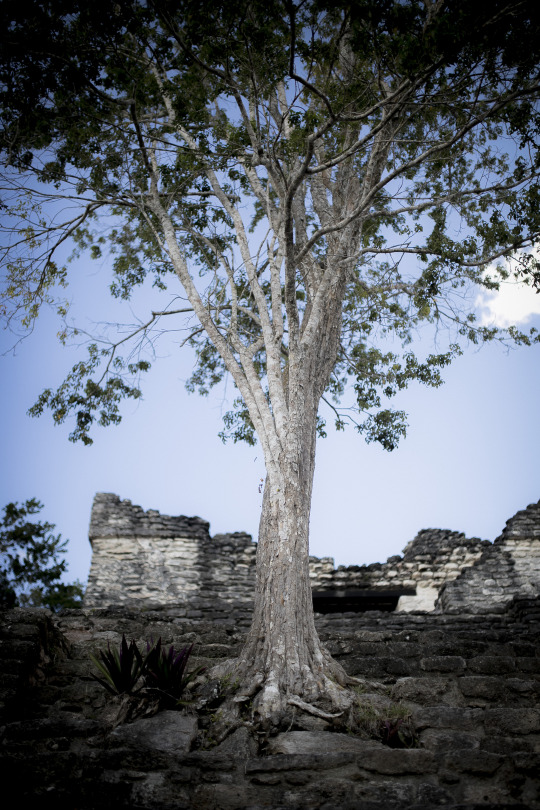



Nature as a celebration. Magnificient Tree of Life hidden in plain sight.
Beaucoup de mots et pensées à venir, de photographies évidemment bien que l'essentiel du travail soit ailleurs. Une terre riche d'informations - à l'interconnectivité évidente - où les données y ont été déposées il y a long afin de pouvoir au mieux processer les Temps présents, uniques dans l'histoire de l'Humanité.
Nous sommes arrivés à ce moment décrit dans l'Histoire, par celle des religions notamment mais bien au-delà, où ce qui est caché se révèle inexorablement. Où la Magie, qui n'est autre que l'Âme qui agit, opère.
Travailler et surtout intégrer cette parfaite et contradictoire dualité mexicaine originelle à l'image de Ometecuhtli & Omecihuatl, bien présente et transmise par les savoirs Mayas et tant d'autres, nous sera salvateur pour ce qui est à venir.
Chiapas. Mexico 2023.
#nature#mexico#tree of life#celebration#photography#travel photography#keep exploring#documentary#beauty#caroline lessire#mexique#chiapas#ceibo#ceibo tree#magic#soul#non duality#soil#Ometecuhtli#Omecihuatl
5 notes
·
View notes
Text

Slowly….
1 note
·
View note
Text

Ometeotl, the divine Aztec originator. From their position in Omeyocan, the highest heaven, all of creation flows forth. Ometeotl consists of a pair of deities, the masculine Ometecuhtli and the feminine Omecihuatl. These two gods split apart from Ometeotl at the beginning of time, together the two birthed the Tezcatlipocas, the first Gods of the universe to be born. From the waters of chaos spawned from Ometeotl another god arose, the monster Cipactli. Once, After the goddess Chantico broke her fast, Ometechutli punished her by transforming her into a dog. The pair of Ometecuhtli and Omecihuatl, even when separated, are still considered interconnected. The two are the prime aspects of Ometeotl rather than distinct entities, from these two each god bellow them represent a lower and lower aspect of Ometeotl.
Ometeotl is a somewhat contested figure in Aztec mythology. Ometeotl wasn’t directly worshipped as prominently as the other gods in the pantheon, and much less than their offspring: the Tezcatlipocas. This has led some to suggest that Ometeotl was a creation of Christian missionaries, but this view has been rejected by many. Ometeotl was probably still an important figure among the Mesoamerican Aztecs, but its transcendental nature lead them to worship other gods for a more direct communication. The Aztec term Teotl, the sacred divinity that permeates existence and exemplified in the gods, is heavily associated with Ometeotl, as Ometeotl is the consciousness of Teotl, or rather it IS Teotl. The pair of Ometecuhtli and Omecihuatl is also named Tōnacātēcuhtli and Tonacacihuatl in other accounts. The concept of Ometeotl, an omnipresent divinity that manifests in the gods, is extremely similar to the Hindu Brahman and even the Vedic Prajapati. Comparisons can also be made between the two emanations of Ometeotl and other Primordial couples, such as the Irish Danu and Donn, the Vedic Dyaus and Prithvi, and even the Taoist view of Yin and Yang to an extent. These comparisons are not suggesting that Aztec spirituality is connected to those of Eurasia, but that similar archetypes exist in the human consciousness.
#duality god#divine couple#art#character design#mythology#deity#supreme god#fertility god#creator god#mesoamerica#mesoamerican mythology#aztec#aztec mythology#ometeotl#omeyocon#teotl#ometecuhtli#omecihuatl#tōnacātēcuhtli#tonacacihuatl#indigenous#mexica
1 note
·
View note
Text

Tōnacātēcuhtli
"The Being at the Center"
Talon Abraxas
Tonacatecuhtli was a food giving and fertility god in Aztec mythology, sometimes said to correspond to the Mayan Omteotl, the supreme god who was both male and female. With his consort Tonacacihuatl, he resided in the Highest Heaven (the thirteenth heaven) and the two represented the primordial male and female principles and creative aspects. Tonacatecuhtli was also a creator god. He did not create life directly, but he created the deities Ometecuhtli and Omecihuatl who were the source of all life. At the creation of the world, he separated the land and the waters.
He was depicted as being clothed in rich garments, which were meant to indicate light. Often wrongly associated with sun or fire gods, he was representative of the sky only and a purely celestial being. He was thought of as the still point at the center of a moving ring, where everything was balanced, and occupied the first place in the calendar. His day was Cipactli (crocodile), which signified advancement and honor. A good day for beginnings, the associated glyph was indicative of energy and work.
Tonacatecuhtli was the father of red Tezcatlipoca, black Tezcatlipoca, Quetzalcoatl, and Huitzilopochtli. He may have been related to Tonatiuh, the sun god.
This god would punish as well as give rewards, though he was not very active in the mythology following the creation of the world. For example, Chantico, the first woman to violate the rule of fasting before making an offering to the gods was punished by Tonacatecuhtli, who turned her into a dog for her crime.
On the other hand, he blessed Tezcatlipoca and Quetzalcoatl by making them lords of the heavens. The two gods had been destroying the various creations: the sun of earth, the sun of wind and the sun of rain, but later atoned for this by turning themselves into two huge trees, thus restoring creation.
23 notes
·
View notes
Text

Xipe Totec: The Flayed God of Aztec Mythology
Xipe Totec's origins trace back to the creation of the universe by the divine dual god Ometeotl and his association with Red Tezcatlipoca, the powerful creator and destroyer god.As the eldest son of the primordial gods Ometecuhtli and Omecihuatl, Xipe Totec was part of a pantheon shared with neighboring ethnic groups, including Tezcatlipoca, Quetzalcoatl, and Huitzilopochtli.
Artistic portrayals show him wearing a yellow or golden flayed skin suit, with intricate stitching and exposed hands, while sculptures emphasize double lips and eye sockets.
He was believed to have invented war and was often depicted wearing the flayed skin of sacrificial victims, symbolizing rebirth and the renewal of the seasons.
Xipe Totec's annual festival, Tlacaxipehualiztli, involved gladiatorial sacrifices, mock skirmishes, and the wearing of flayed skins by victorious warriors. The flayed skins were believed to have curative properties, and people would touch them to seek relief from ailments.
Xipe Totec was also associated with diseases such as smallpox, blisters, and eye sickness, and offerings were made to him for healing. Xipe Totec was also the patron god of goldsmiths, and gold held sacred status, with the Nahuatl word for gold, teocuitatl, meaning "excrement of the gods." Stealing gold was a severe crime punishable by being skinned alive during Xipe Totec's annual festival.
The worship of Xipe Totec was widespread in central Mexico and throughout Mesoamerica, with representations found as far as El Salvador.
Follow @mecthology for more mythology and lores. Source: www.mexicolore.co.uk, mythopedia.com & wikipedia
#xipe totec#aztec gods#aztec mythology#aztec#mecthology#scary gods#divine#ancient#religion#mythology#mythical#mitoloji
7 notes
·
View notes
Text
Link to the first chapter of my Rocket Racoon fic!
9 notes
·
View notes
Text

I wanna talk about the lil snakes I wanna put into the background of the cosmic fault, I wanted them to represent the idea of the world tree a little, lots of mesomerican beliefs were centered around trees!!


Lots of creator Deities were said to have created the world from a trees and even people from trees!!
The two snakes are my interpretation of these codices and myths, being the dual Creator god and goddess Ometeotl
or Ometecuhtli and Omecihuatl on their own!!!
The snakes were my idea of capturing the fantasy of the world, they're they're to remind you they're always snaking in and out of the world, like they're weaving it together
31 notes
·
View notes
Photo

Le Nahual - Mexica (Aztec)
The concept of the Nahual in Mesoamerica is an ancient tradition, which stretches back at least 3000 years. In another painting, “La Bruja de Zempoala,” I explored a modern image of Nahualism, in which a woman flies over a church and town accompanied by her tonales, her “spirit animals,” which take the form of alibrijes, which are a modern conception of what a tonal looks like. In this painting, “Le Nahual,” a prehispanic image of the nahual is explored. A “tonal” or “spirit animal” is a soul or animating energy which lives within us. When we sleep, our tonal leaves our body and travels through the world of the gods and ancestors, which we experience as dreams. Our tonal is not a separate thing to which we are linked, but is rather another manifestation of we, ourselves. A nahual is a special person, who has the ability to consciously transform into their tonal. This can mean that they physically become their animal spirit, or that they become two entities, a human meditating in their place, and a tonal which moves out into the world. Yet, even though they are two, they are still both the same being. If the tonal is killed, the nahual will die in the exact same way. In my painting, a nahual is depicted, flying over prehispanic Mexico, transforming into their tonal, an eagle. This painting is inspired by an ancient tradition of Mesoamerican art, in which animals wear human masks. In these sculptures, the animal is revealed to be a tonal, the mask their human Nahual. Here, the eagle wears the mask of the nahual, while the human riding on his back wears the eagle´s mask, to indicate that they are both one single being. The nahual´s body is painted yellow. In prehispanic Nahua cultures, women painted their bodies yellow as a sign of beauty. They are thus revealed to be Xochihua, a third gender, which are neither male nor female, but both. Xochihua people were often priests or priestesses, and held in honor, as containing within themselves both the male energy of Ometecuhtli, and the female energy of Omecihuatl, and thus being closer to divine sources of power and wisdom. I imagined the scene as taking place during the era of the Mexica empire, yet they have painted their body with Olmec glyphs. The Olmec were the most ancient culture of Mesoamerica, from whom all later culture and wisdom flowed. The nahual thus calls upon the Teteo and the ancestors through occult and powerful glyphs which were ancient in their own time. The glyphs reveal the gods of the four directions, the trees which hold the skies in their place, and hands, with which they weave their spells.
Art and text by Mexica Heart:
https://www.etsy.com/au/listing/1114417648/le-nahual-mexica-aztec-spirit-animal
62 notes
·
View notes
Text
Tezcatlipoca, or "One Leg".
NO. 1
Tezcatlipoca is the god of the night sky, hurricanes, obsidian, conflict, and providence. When depicted, he usually wore a talisman with a disk worn as a chest pectoral. While depicted with black and yellow stripes painted across his face, he is usually shown with his left foot replaced with an obsidian mirror, bone, or snake, as it was lost to the sea monster Cipactli in the mythos. In the Aztec religion, he was the central deity. In Aztec or Mesoamerican folklore, he and other gods could shapeshift, and he was no different as his counterpart was the illusive but powerful jaguar, which is why he is known as the jaguar god.
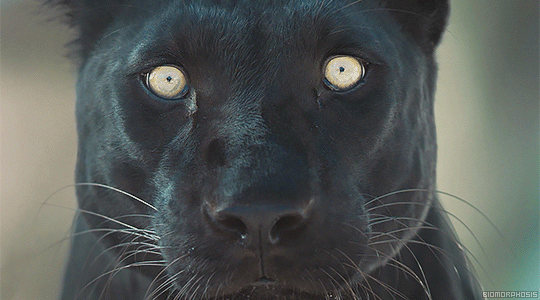
NO. 2
This figure is extremely popular, and worshipped by the Mayan and Olmec communities. His name in the Mesoamerican language means ‘Smoking Mirror.’ This deity has numerous epithets which allude to different characteristics, like Ipalnemoani ("He by Whom We Live"), Necoc Yaotl ("Enemy of Both Sides"), and Tioque Nahuaque (‘Lord of the Near and the Night’), etc. His power to omnipresence was more a connection that extended far beyond obsidian since ritual bloodletting and human sacrifice were conducted with obsidian. Apart from being a creator god, he was also a trickster and ruled over the modern Aztec pantheon.
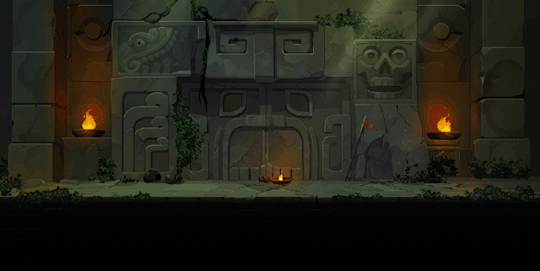
NO. 3
Tezcatlipoca, according to Aztec mythology, was born to the primordial creator deities Ometecuhtli and Omecihuatl, and had four siblings; one of whom, Quetzalcoatl, the god of the wind, patron of priests, and inventor of calendars and books; he was known as the Serpent Feathered god. The brothers feuded as much as they worked together, working towards the same goal but sometimes in opposition towards each other. After being born, this deity spent over 600 years for his youngest brother Huitzilopochtli to grow flesh before Tezcatlipoca and Quetzalcoatl, together, made the world. Before the world was made, the only thing that was technically alive were a few gods, a massive ocean and the sea monster, Cipactli, which Tezcatlipoca successfully lured away and killed by using his foot as bait. Both brothers were able to create the world on the sea monster’s body.
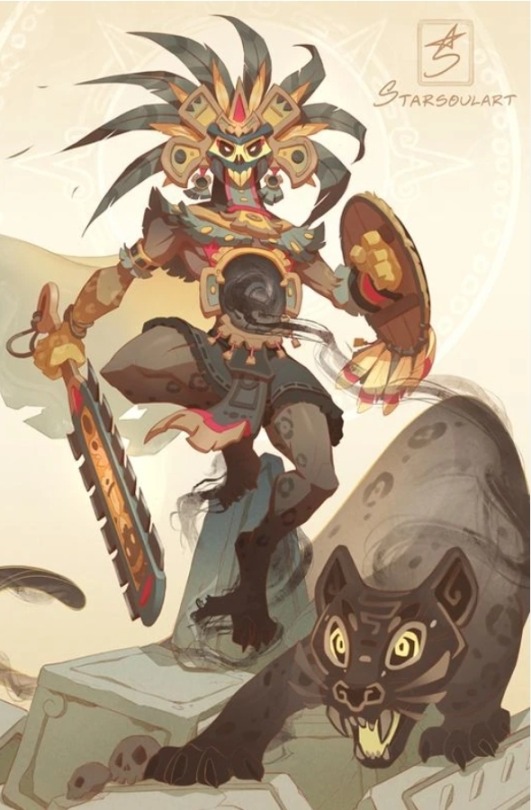
#aztex myths#aztec gods#mythos#mythology#folklore#jaguar gods#animal gods#spirits#symbology#Meso-American#mayan#mayangods#mayanmythology
16 notes
·
View notes
Text
Cold winter: Tezcatlipoca
TEZCATLIPOCA
Category: Aztec mythology
Tezcatlipoca is one of the main gods of the Aztec pantheon, and one of the four deities known collectively as the “Tezcatlipocas” (Tezcatlipoca proper being the Black Tezcatlipoca, ruler of the North). He was also known by several other names such as Titlacauan (We are his slaves), Ipalnemoani (He by whom we live), Ome Acatl (Two reed), Yohualli Ehecalt (Night wind), Necoc Yaotl (Enemy of both sides), Tloque Nahuaque (Lord of the near and the night), or Ilhuicahua Tlalticpaque (Possessor of the sky and earth). As you can tell by these various titles, he was a pretty ominous guy.
I) Attributes
As his title indicates, Tezcatlipoca was renowned for being a god associated with the color black, either with his body being black, or by having black lines of paint over his face (alongside yellow lines). He typically was depicted wearing a loincloth, knotted sandals, armbands, and a headdress made of heron feathers (with sometimes tinker bells around his ankles or neck). Tezcatlipoca is also usually seen holding several different items: arrows, a spear, a fan of feathers surrounding a mirror, or a shield with on it a ball of either feather or cotton.
One of the key features of Tezcatlipoca is that he only has one full leg, his right foot rather being replaced by either a snake, a bone, or an obsidian mirror. Interestingly, sometimes the obsidian mirror wasn’t replacing his missing feet, but rather attached to his chest, with smoke rising from it. Other depictions (and interpretations of this depiction) keep the idea of a disc strapped to the god’s chest, but lean more towards some sort of talisman carved out of abalone shell. But the idea of a smoking obsidian mirror is very interesting because Tezcatlipoca’s very name means… “smoking mirror”. And the reason his mirror is always obsidian, beyond the fact that obsidian was Tezcatlipoca’s sacred material, is… simply because Aztec mirrors were made of obsidian. That’s it. BUT mirrors in the Aztec society weren’t just every day item, they were rather used for specific prophetic rituals. Which is why, through his mirror, Tezcatlipoca is both the god of obsidian and the god of divination.
In fact the full list of Tezcatlipoca’s domain is actually pretty long, ranging from neutral things (rulership, sorcery, divination, north) to natural elements (obsidian, the night sky, night winds, the earth) – but most of his attributes were actually negative or downright evil. He was the god of hostility and discord, the patron of temptation and conflict, as well as the deity of the hurricanes. His only positive traits being that he was also a god of beauty, and a god of war. (Note: For the Aztecs, war is life. Literally. They had a mentality similar to the Norse where war was a beautiful, honorable thing on which their society relied and that they hoped to die in to get into paradise) Tezcatlipoca’s duality is well manifested in the various songs and prayers to him that honor the deity as “the Giver of Life”, “a poet and a scribe” – but more importantly as “the creator and the destroyer of the world”.
As with all the Aztec gods, Tezcatlipoca had a totem animal, and his was the jaguar. In fact, the jaguar deity known as Tepeyollotl was simply interpreted as being Tezcatlipoca when he manifested in his “jaguar aspect”.
II) Myths
Tezcatlipoca was thought to be one of the four sons of the primordial divine couple, Ometecuhtli and Omecihuatl, alongside the other three “Tezcatlipocas”: Xipe Totec, the Red Tezcatlipoca, Huitzilopochtli the Blue Tezcatlipoca, and Quetzalcoatl the White Tezcatlipoca. And the latter was known in texts as the regular enemy of Tezcatlipoca: the Black and the White god were renowned as bitter rivals constantly fighting with each other.
There are two main legends concerning Tezcatlipoca, both being creation-myths retelling the origins of the world.
The first is the legend of Cipactli. According to this legend, before the world was created it was only a vast sea inhabited by a monstrous entity known as Cipactli. Quetzalcoatl and Tezcatlipoca teamed up to create a world, but they could not do it as long as the destructive sea monster was there, so the gods planned to get rid of her. Tezcatlipoca plunged his right foot into the sea, for Cipactli was known to be eternally hungry – and the creature took the bait by eating the god’s foot, but this led to her capture. The two gods then distorted and reshaped the monster’s body so that it would become the land and continents we know today, before creating humanity to populate their new world. And ever since this day Tezcatlipoca is a one-foot god, while humanity brings offering to Cipactli – for while distorted, reshaped and immobilized, the monster is still alive and in pain, and when it groans or shakes it causes earthquakes humans must appease with food, to satiate her eternal hunger.
The second myth is much more well-known and famous: it is the Five Suns myth. According to this legend, there were five different world that existed one after another – each called a “Sun”, because the lifespan of a world was tied to the one of its sun. According to some traditions, when a god created a world he became the “Sun” of it – but other versions of the myth rather claim that each world was created collectively by all the gods, before they chose one specific deity to become its sun and bring light to it. All in all we know that Tezcatlipoca was the first sun of the first world, where men were renowned for their gigantic heights – but as it turns out he was a bad sun. Some say it was because he was a god of night and darkness, others say it was because he missed a foot, but overall he produced a dim, half-light and was a very poor sun, so Quetzalcoatl, unsatisfied with his brother’s job, knocked him out of the sky with a stone club. It created an endless night, and Tezcatlipoca was so enraged at being fired from his job that he ordered all of the jaguars in the world to devour humanity (or he himself turned into a gigantic jaguar to destroy the world in a fit of rage) – and so the first world ended.
Afterward Tezcatlipoca ended up playing a role in each of the future suns demises, probably jealous and bitter at the whole “first sun” ordeal. When Quetzalcoatl became the second sun, he loved too much his humans and pampered them, leading them to become uncivilized, bestial and unreligious. Tezcatlipoca, acting as a force of “authority and judgement” quickly stepped in to settle the matter. Some versions say he used his sorcery to turn all the humans into monkeys, and Quetzalcoatl, angry, send a huge wind to wipe off the surface of the earth and end his world ; others claim that rather Tezcatlipoca forced Quetzalcoatl to create a huge hurricane to destroy his world, while the few surviving humans naturally devolved into monkeys. When Tlaloc, the god of rain, became the third sun, Tezcatlipoca used a sly plan – he seduced and stole away Tlaloc’s wife, the goddess Xochiquetzal, and out of grief Tlaloc stopped all rain. As humanity begged him constantly to make it rain, he grew angry and in an outburst of rage caused a rain of fire that burned all of the world away – the few surviving humans becoming birds. When a fourth world was created out of the third’s ashes, Chalchihuitlicue the goddess of water became its sun – but Tezcatlipoca accused her of putting the façade of a loving goddess in front of her “true” selfishness, to be an hypocrite faking kindness merely to be praised by humanity. These harsh accusations hurt the actually very kind goddess, who cried blood for many years, her tears causing an enormous flood that destroyed the fourth world, with the few remaining survivors becoming fishes.
The only world/sun Tezcatlipoca hasn’t touched or destroyed yet is the Fifth, the one we live in today, the sun of the god Huitzilopochtli. Or at least… he hasn’t tried yet.
III) Worship
The festival of Tezcatlipoca was called Toxcatl, and held in what we know today as the month of May. Each Toxcatl festival a young man was selected to become an ixiptlatli (an “impersonator” that is to say a form of actor embodying and representing a god for ritual purpose) – usually a war prisoner and a warrior (though sometimes slaves were bought, even though they had to be bathed by priests to be free of impurities). Throughout the year the Tezcatlipoca-impersonator would parade in the streets of Tenochtitlan (Aztec empire capital) in a Tezcatlipoca outfit (skin painted black, precious jewelry, embroidered cotton clothes, snail-shell lip pendant, headdress of eagle feathers, bracelets of turquoise and golden bells at his ankles) and be treated with outmost reverence as if he was the god himself. He was taught courtly speech, the art of singing, and how to play a flute, because his activities were to play the flute, smoke tobacco, burn copal incense and smell flowers everywhere he went. The impersonator would regularly be adorned by the Aztec emperor himself, and in the month previous to the next Toxcalt the impersonator would be wed to four maidens embodying four different goddesses (Xochiquetzal, Xilonen, Huixtocihuatl and Atlatonan). He lived with them for twenty whole days, and it should be noted that before this wedding the impersonator was to follow a strict rule of abstinence.
The week before the next Toxcalt the fake-Tezcatlipoca spent his days singing, dancing and feasting as merrily as he could, and four days before the next Toxcalt he would parade with his wife through the streets. On the next Toxcalt the group would travel by a small boat to a sacred island, where the fake Tezcatlipoca would leave his wives at a temple before climbing the stair of a pyramid – breaking a flute with each step. At the top of the pyramid, he was laid on a sacrificial stone and there ritualistically killed: his chest opened with an obsidian dagger to remove his heart, his head cut off so that his skull could be displayed, his body flayed, and finally his flesh given to eat to the nobles of the city. Then, a part of the god’s flesh was given to another young male war-captive, who also wore the skin of the impersonator, and thus he was to become the next ixiptlatli of Tezcatlipoca for a whole new year.
This festival was a BIG thing in the Aztec empire: all throughout it people prepared offerings of food and flowers for the gods, and many dances were performed that involved lot of “kissing and playing between men and women”: men danced the “dance of the snake”, women danced “the dance of the grilled corn”, and when presenting offerings people did “the leap of Toxcatl”. We also known that after these dances, participants to the festival were usually to receive ritualistic scars by the priests of Tezcatlipoca.
This whole sacrificial festival was seen as something of outmost importance for the nobility because Tezcatlipoca was seen as the patron deity of the royal house, and so each Aztec ruler had to be very faithful to him, with numerous hymns having the emperor comparing himself to a “blind, deaf imbecile” or an “excrement” in front of the “lord of the night and the wind who is our master”, and other texts identifying Aztec rulers as mere vessels expressing the god’s will and speaking with the god’s voice. Similarly, the Tezcatlipoca impersonator was always described as climbing the sacrificial staircase with “dignity and pride” because being killed in this ritual was seen as a great honor. The entire ceremony has been interpreted in numerous ways by scholars, with unsure and conflicting theories – the most common being that this ritual was a form of renewal ritual that could mean the chance of seasons or the cycle of deaths and rebirths ; others reject the idea that the festival was held in May and rather see it as a fall festival for the harvest celebration ; some argue it was simply a grandiose sacrifice offered by the Aztec ruler to the very god of rulership to maintain his power to dominate the empire ; and people have pointed out a possible interpretation of the “twenty days of sexuality culminating in a sacrifice” after one year of abstinence symbolized a period of fertility at the end of a drought.
- - - - -
Another genealogy I haven’t talked about claims that the four Tezcatlipocas were born out of another primordial Aztec goddess, Coatlicue (you might know her as the two-snakes-headed lady) – in the myth Quetzalcoatl was her firstborn, alongside his twin Xolotl, born of the goddess as she was still a virgin ; Tezcatlipoca only being born second, fathered by… an obsidian knife. Then following the Tzitzmitil, the gods of the stars, and finally Huitzilopochtli, the god of the sun, born out of a… ball of feathers. Similarly the creation myths I detailed above have several variants : for example, while some claim in the Cipactli legend that only Quetzalcoatl and Tezcatlipoca did the “creating the world” business, others talk of them as merely being responsible for the “fishing” of the primordial sea-monster, and binding it outside of the water, while the whole “reshaping her body into the land” was done by their brothers, Xipe Totec and Huitzilopochtli. A third yet claims that Tezcatlipoca did the whole “capturing Cipactli” alone, and that it was him who alone dismembered the hungry water creature to create the land (hence his title as god of the earth).
A small note for a deity connected to Tezcatlipoca: Tepeyollotl, an Aztec god whose name means “heart of the mountains” or “mountain-heart”. He was the god of the “eighth hour of the night”, usually depicted as a jaguar leaping towards the sun or as a jaguar-skin-wearing man with crossed eyes and a white staff ornated with green feathers. He was a spirit of dark caves, echoes and earthquakes and… despite the two being identified as different deities, he also seems to have been Tezcatlipoca. Several texts imply that Tepeyollotl was the identity Tezcatlipoca took when he put on the skin of a jaguar or turned into a jaguar, thus this being his “jaguar counterpart” (or his *cough cough* furry persona *cough cough). Other rather point out that Tepeyollotl might have been intended to be a fake identity or disguise in-universe, that Tezcatlipoca used to trick and deceive other people.
13 notes
·
View notes
Text
I’m calling it now. Tez is a puppet for the real villain. And if my knowledge on mythology tracks, the real villain behind it all is Itzpapalotl, the queen of the Tzitzimime (also hnnnghnngh pretty butterfly lady 😳)
Also it seems that the show is taking the route of Ometecuhtli and Omecihuatl being the parents of the four Tezcatlipocas. It seems like Tez, Xipe, and Huitzi all still have knowledge of their godliness. But Sal, for some reason, does not, despite seemingly being aware of his godly powers. I have a theory on that.
Tez said his leg was taken by a winged snake, and in Aztec Mythos the rivalry between Quetzalcoatl and Tezcatlipoca was the driving force for much of the conflict that shaped the world into the way it is today. So my theory is that Tez and Sal got into a fight, a really bad one. Sal took Tez’s leg and Tez took Sal’s memories/sanity in return. I mean, Sal doesn’t even seem to remember Ometecuhtli and Omecihuatl despite literally being related to them.
I also think Huitzi might have gotten mixed up in this whole sibling-fight situation and ended up getting trapped in his hummingbird form, which is why he isn’t able to turn into a humanoid form like his brothers are.
Side note: the reference to Mayahuel in the song gave me life but also crushed my heart because I’m such a MayaCoatl shipper 😭😭😭
#victor and valentino#v&v spoilers#Victor and Valentino spoilers#mythology#theories#fan theories#Aztec#tezcatlipoca#quetzalcoatl#xipe totec#huitzilopochtli#Ometeotl#ometecuhtli#Omecihuatl#Itzpapalotl#Tzitzimime#Mayahuel
55 notes
·
View notes
Photo


Ometecuhtli and Omecihuatl, dual gods in Aztec mythology.
132 notes
·
View notes
Text
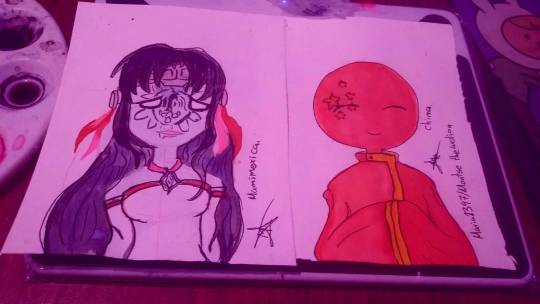

Un par de entintados spoilers de mi comic dioses del pasado. Espero que les guste. ^0^ mami mexica con nuevo estilo pero #mejorare.
#countryhumansmexico#countryhumans#countryhumanchina#country humans#countryhumanimperiomexica#mexico#china#imperiomexica#quetzalcoatl#omecihuatl
13 notes
·
View notes
Text


“Tonatiuh, the Verb of San Juan, the Logos or creator of the universe, with its triangular tongue of fire, is the golden child of sexual alchemy, the spiritual sun at midnight, the eagle that rises and soars, the resplendent dragon of wisdom, and it is represented by the star that gives us life, light and heat. Decorated by the Nahualts, it appears in glory at the very center of the Stone of the Sun”.
-Samael Aun Weor – The Secret Doctrine of Anahuac.
Tonatiuh, God of the Sun
Talon Abraxas
In each and every corner of the world, mankind has strived to give tangible representations to personify the great realities of the spirit. It should not amaze us that the Incas, Mayas, Aztecs, Egyptians, etc. resembled the sun with the universal spirit of life in an attempt to relate its physical and spiritual characteristics. In this way, they taught others about the greatness of that which is intangible. Undoubtedly the sun has been, is, and will be the means to allow the world to understand what truly is the Spirit of the Being within each one of us. Just like the physical sun imparts life, light and warmth, our Being gives us spiritual life, wisdom and wishes to learn that which is mystical.
Among the Aztecs, the God of the Sun was called Tonatiuh (Tona = the maker of the sun and heat, tiuth = to go). In universal Gnosticism, is it the Being or the Spirit the one who imparts life, and at the same time, the sun is the symbol each aspirant should manifest within: to create the sun is to integrate oneself with the Being.
The God of the Sun, Tonatiuh, is represented in the microcosm by the Intimate, the most spiritual element within each man and woman. In the macrocosm he is the Solar Logos or the Divinity. Either one will trigger our impulse towards the self-realization of our Being, using as its means awakening that is both mystical and spiritual.
In Nahuan culture, as in others, the Sun was the symbol of the Father, the eternal Masculine Principle; the Moon, the mother or the eternal Divine Feminine Principle, and Venus, the symbol of the Celestial Child. Tonatiuh, the God of the Sun, is the incarnation and expression of the fire that comes from the heavens. Tonatiuh is the representation of the divine aspects and itself explains the creation of all that exists.
The wise Aztecs of Anahuac gave the creator both: masculine and feminine form. The creator in its masculine aspect was called Ometecuhtli (ome = two, tecuhtli = Lord), and the divine feminine principle Omecihuatl (ome = two, cihuatl = Lady). They are the Lord and the Lady, God and Goddess of Duality. On this aspect, VM
Samael Aun Weor states:
“The face of Tonatiuh in the Aztec calendar is the face of Ometecuhtli-Omecihatl, Lord and Lady of duality, God of life, of love and generation.”
“Enclosed by two concentric circles, around which are four squares within two other concentric circles (the unmanifested absolute: Ipalnemohuani), encompass it all: the feline claws of Quetzalcoatl ripping human hearts, the Sun of Wind or 4 Ehecatl, the Sun of Fire or 4 Quiahuitl, the Sun of Water or 4 Atl, the Sun of Jaguar or 4 Ocelot and the Sun of Movement or 4 Olin, the East and the West, the North and the South, the twenty days of the month, etc.”
“This explains why the Nahuans venerated the Sun and the dual significance the numbers had for them.”
Samael Aun Weor – Aztec Christic Magic, Monogram No. 8
Tonatuih’s crown or Xiuhitzolli represents the Ancient of Days, the Kaballistic Kether, the three aspects of divinity: the Father, Son and Holy Spirit, the Logoic triangle of the Hebrews.
Each man has its own particular ray, resplendent in all its glory and might in the world of the ineffable Gods; the golden ray, the Being of our Being, the internal Christ of each man. It is the Sephirotic crown of the cabbalists, the Crown of Life. “Be faithful till thy death (says the Holy One), and I shall give thee the Crown of Life”. (Revelations 2:10).
We will find all the attributes of divinity wisely expressed in their artistic forms by the wise of Anahuac, as we can tell from the date of Two Canes in its crown. The number 2 (both circles) represent the feminine and masculine aspects of divinity.
“Ometecuhtli-Omecihuatl, Lord and Lady of duality. “Ome”: two; “Tecuhtli”: Lord. “Ome”: two; “Cihuatl”: Lady. From this divine dual principle, masculine and feminine, emanated the Universe. This God-Goddess had four sons, the four Tezcatlipocas: Xipotec, the red one; Tezcatlipoca, the black one; Quetzalcoatl, the white one; Hizilopochtli, the blue one.”
“From this divine and indivisible binary were born the four colors of the four races that populate the Earth. Ometecuhtli has the presence of the Cosmis Christ. The Nahuas represented him with a beautifully adorned tunic and a stone phallus, symbol of light. Omecihuatl has all the presence of the Cosmic Virgin.”
“The Nahuas represented her with a beautiful blue mantle…”
“He is Huehueteotl, the Ancient God, father of the gods and father of men. She is Tonantzín, our beloved Mother.”
Samael Aun Weor – Aztec Christic Magic, Monograph No. 10
The three eagle feathers of the symbol of the cane, or Acatl, together with the pearl, represent the Greek TETRAGRAMMATON, the holy FOUR, symbol of the Trinity plus that which is unmanifested.
In ancient times the hair was directly related to the creative energies, similar to what we have seen in the myth of Sampson and Delilah on the Hebrew kabala.
The wrinkles around his eyes allegorize the wisdom we should reach by awakening our consciousness in our daily living. Among the Aztecs, the maximum authority was represented by a council of elders, who had dedicated their lives to the elimination of their egocentric interests.
The eyes of the God of the Sun are the eyes of the Internal Father, who sees all, who is always vigilant to that which we think, do and feel.
In the nose or Yacaxihuitl we find a wise combination between the breath that imparts life and the work with the masculine and feminine forces, as we see three eagle feathers on each side. The number 6 (3 feathers on each side) represents the crossing of these forces.
The Borgia Codex mentions the ritual of the perforation of the nose. This ritual is intimately related to the science of sexual transmutation through breaths, breathing and respiration.
The Solar Logos emanates all its creative might to this world and then collects it transmuted, to impart himself life. In a similar manner, the human being should imitate this process.
The tongue in shape of a blade or Tecpatl, is the verb, the word, the Logos, the power the verb has manifested in all that has been created. Curiously, we find in the tongue an eye, symbol of psychological self-observation, showing the necessity of being attentive to what we say, as the verb carries extensive responsibility. In addition, we find a claw that shows the power of the word. With the word we can bless or damn, aid or cause suffering. This shows us the sacrifice the initiate must undergo to ensure the right use of the word. The word has the power to create, which is why it is necessary to develop self-observation as well as a sense of responsibility in its use. We need to learn when to speak and when to be silent.
“In the beginning it was the Word, and the Word was with God and the Word was God. This was in the beginning with God. All things by Him were created, and without Him none of what is would be. In Him was life, and life was the Light of men.”
St. John, 1:1-4, Bible of Casiodoro de Reyna, 1569.
In the Chalchihuitl (precious stones) we see six jades forming Tonatiuh’s collar. These symbolize the virtues of the soul: tenacity, patience, willpower, altruism, philanthropy, love… all acquired through the destruction of the undesirable psychological aggregates we carry within.
In his ears or Xiuhnacochtli we see that from the shape of the circle emanates an adornment of three eagle feathers. The circle is a symbol of eternity, the unknown absolute, that which the Greek referred to as Agnostos Theos (the unknowable God which cannot be defined). In Sanscrit it is known as Sat (That). From that which has no name emanates the trinity of the Father, the Son and the Holy Spirit, and as a result, the Holy Four: the Tetragrammaton.
The ears show by themselves the need to listen to that which is spiritual, to closing our ears to blasphemy, damnation, prejudices and all unsubstantial words of the ego, but to place our attention in the Voice of the Silence, the Wisdom of our Father.
“Ears with large pendants show the need to learn to listen, to place our attention to wisdom.”
Samael Aun Weor – Mayan Mysteries
18 notes
·
View notes
Text
Cosmovisión Mexica
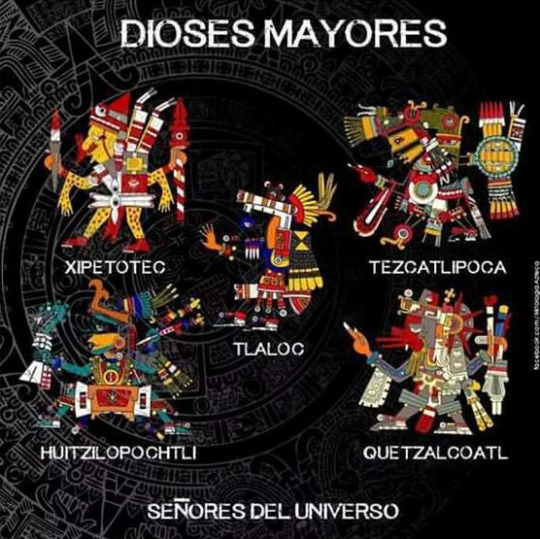
Según la cosmogonía Mexica, Quetzalcóatl es hijo de la dualidad creadora del universo Ometeótl, formado por Ometecuhtli y Omecíhuatl. Sus hermanos eran Huitzilopochtli, Tezcatlipoca y Xipe-Tótec.
#quetzalcoatl#tezcatlipoca#huitzilopochtli#ometeotl#xipetotec#ometecuhtli#omecihuatl#mexica#mexico#aztecart#mitologia azteca#mitologia#diosesaztecas#dios azteca#mictlan
68 notes
·
View notes
Photo

De regreso al #temazacallipachamama despues de casi 4 años de ausencia. #tloquenahuaque #ometeotl #omecihuatl #Tlazocamati https://www.instagram.com/p/CfSdveRrUXD/?igshid=NGJjMDIxMWI=
0 notes